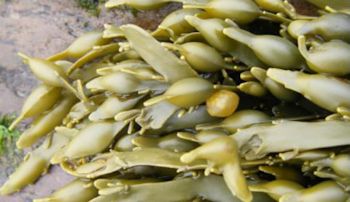Netzsch Pumps Smooth Processing for Seaweed Harvester
For a plant that processes hard-to-handle seaweed into agricultural fertilizer products, a successful trial of a Netzsch progressing cavity pump led to an installation with low total cost of ownership.

During processing, the Ascophyl-lum Nodosum seaweed extract becomes a very viscous liquid and difficult to transport. (Image: Netzsch)
A Canadian-based company specializing in the manufacture and distribution of marine and seaweed-based products is located in a maritime region. This location provides easy access to the fresh marine raw materials they need – specifically, the seaweed Ascophyllum Nodosum.
The seaweed is harvested by tractor at low tide, with areas worked on a rotating basis in order to allow the seaweed to grow back. After harvesting, the seaweed is dried on-site in greenhouses to ensure the optimal preservation of the raw material — which is ulti-mately processed to yield high-quality crop fertilizer and soil additives.
In processing the seaweed, the raw product has hot water and caustic solution added in a 11,000 litre tank. This is then mixed until the lengths of seaweed dissolve and the mixture becomes more fluid. From the tank the liquid is transferred by a Netzsch Nemo progressing cavity pump into a centrifuge, where the solution is dewatered (decanted).
Efficient conveying system sought
After the seaweed extract is dewatered, the remaining seaweed extract is very viscous – having a thick, sticky gelatinous consistency, somewhere between solid and liquid. The extract has a high PH value, and is running at approximately 90 degrees Celsius. To convey the dewatered seaweed extract from a centrifuge to packaging areas in the plant the customer first tested a conveyor positioned at the discharge of the centrifuge. The open nature and inflexibility of the conveyor solution brought the customer to seek an alternative solution.
Netzsch already had a Nemo progressive cavity pump at the plant used for feeding a centrifuge, so the customer contracted Netzsch to provide a custom solution. During a pump trial at the processing plant, the trial pump was even able to overcome pressures incurred when the client chose to split the discharge hose and serve two packaging areas. This eliminated the need for separate batches serving the same purpose, increasing production efficiencies. Final pump selection was based on the trial pump, which provided valuable insights. On-site consultations between Netzsch sales engineers and the customer during the trial run were also a major factor in selecting Netzsch equipment.
Nemo BF pump selected for service
The Nemo BF pump selected for this application is used in all branches of industry to provide continuous, pressure-stable, gentle and low-pulsation conveyance with dosing in proportion to rotational speed. It is employed primarily for highly viscous, compacted and crumbly substances that do not have a tendency to bridge.
The Nemo pump selected for the seaweed processing application features an open hopper design in stainless steel construction with special feed screw, and a stainless steel rotor suitable for 60 degrees Centigrade. The patented design of the pump feed screw allowed the Netzsch pump to succeed in this application where other systems failed. The feed screw design overfeeds the pump chamber creating a mixing and homogenising effect in the force feed chamber, by introducing a backflow through the gap between the feed screw and the hopper housing. Also, the screw rises above the joints on both the drive side and the rotor side, thus avoiding dead areas in the joint region. The customer also requested a Nemolast S46 food-grade stator and packed gland.
With the Netzsch pump, the customer is now able to cleanly and efficiently move product throughout the plant to different packaging areas. In lieu of the open conveying system that was originally considered, the closed system of the Netzsch pumping solution also eliminates production odours.
The Netzsch open hopper pump was installed in late summer 2013, delivering exactly the performance that the trial pump demonstrated.


